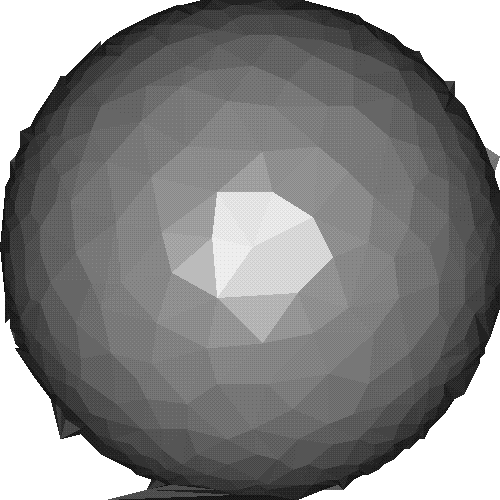




Next: Mesh Refinement
Up: Incremental DELAUNAY TRIANGULATION and
Previous: Conforming Triangulation
Often, a velocity field (or other object that we want to triangulate)
is defined on a regular Cartesian grid. One way to perform a
triangulation in this case is to select a smaller subset of the
initial grid points, using them as the input to a triangulation
program. We need to select the points in a way that preserves the main
features of the original image, while removing some unnecessary
redundancy in the regular grid description.
sphere
Figure 10 Illustration of Garland's
algorithm for triangulation of height fields. The left plot shows
the input image of a sphere, containing 100 by 100 pixels. The
middle plot shows 500 pixels, selected by the algorithm and
triangulated. The right plot is the result of local plane
interpolation of the triangulated surface.





Garland and Heckbert 1996 surveyed different approaches
to this problem and proposed a fast version of the incremental
greedy insertion algorithm. Their algorithm adds points
incrementally, selecting at each step the point with the maximum
interpolation error with respect to the current triangulation. Though
a straightforward implementation of this idea would lead to an
unacceptably slow algorithm, Garland and Heckbert have discovered
several sources for speeding it up. First, we can take advantage of
the fact that only a small area of the current triangulation gets
updated at each step. Therefore, it is sufficient to recompute the
interpolation error only inside this area. Second, the maximum
extraction procedure can be implemented very efficiently with a
priority queue data structure.
opengl
Figure 11 An image from the previous
example, as rendered by the OpenGL library. The shades on polygonal
(triangulated) sides are exaggerated by a simulation of the direct
light source.
|
|  |

Figure 10 illustrates this algorithm with a simple
example. The original image (the left plot) contained 10,000 points,
laid out on a regular rectangular grid. The algorithm selects a
smaller number of points and immediately triangulates them (the middle
plot). The image can be reconstructed by local plane interpolation
(the right plot.) The reconstruction quality can be further improved
by increasing the number of triangles. Figure 11 shows
the same image as rendered by the OpenGL graphics library
Woo et al. (1997).
marmousi
Figure 12 Applying the height triangulation algorithm
to the Marmousi model. The left plot shows a smoothed and windowed
version of the Marmousi model. The middle plot is a result of
10,000-point triangulation, followed by linear interpolation. The
right plot shows the difference between the two images.





Figure 12 shows an application of the height
triangulation algorithm to the famous Marmousi model. The left plot
shows a smoothed and windowed version of the Marmousi, plotted on a
501 by 376 computational grid. In the middle plot, 10,000 points from
the original 188,376 were selected for triangulation and interpolated
back to the rectangular grid. The right plot demonstates the small
difference between the two images.





Next: Mesh Refinement
Up: Incremental DELAUNAY TRIANGULATION and
Previous: Conforming Triangulation
Stanford Exploration Project
9/12/2000


